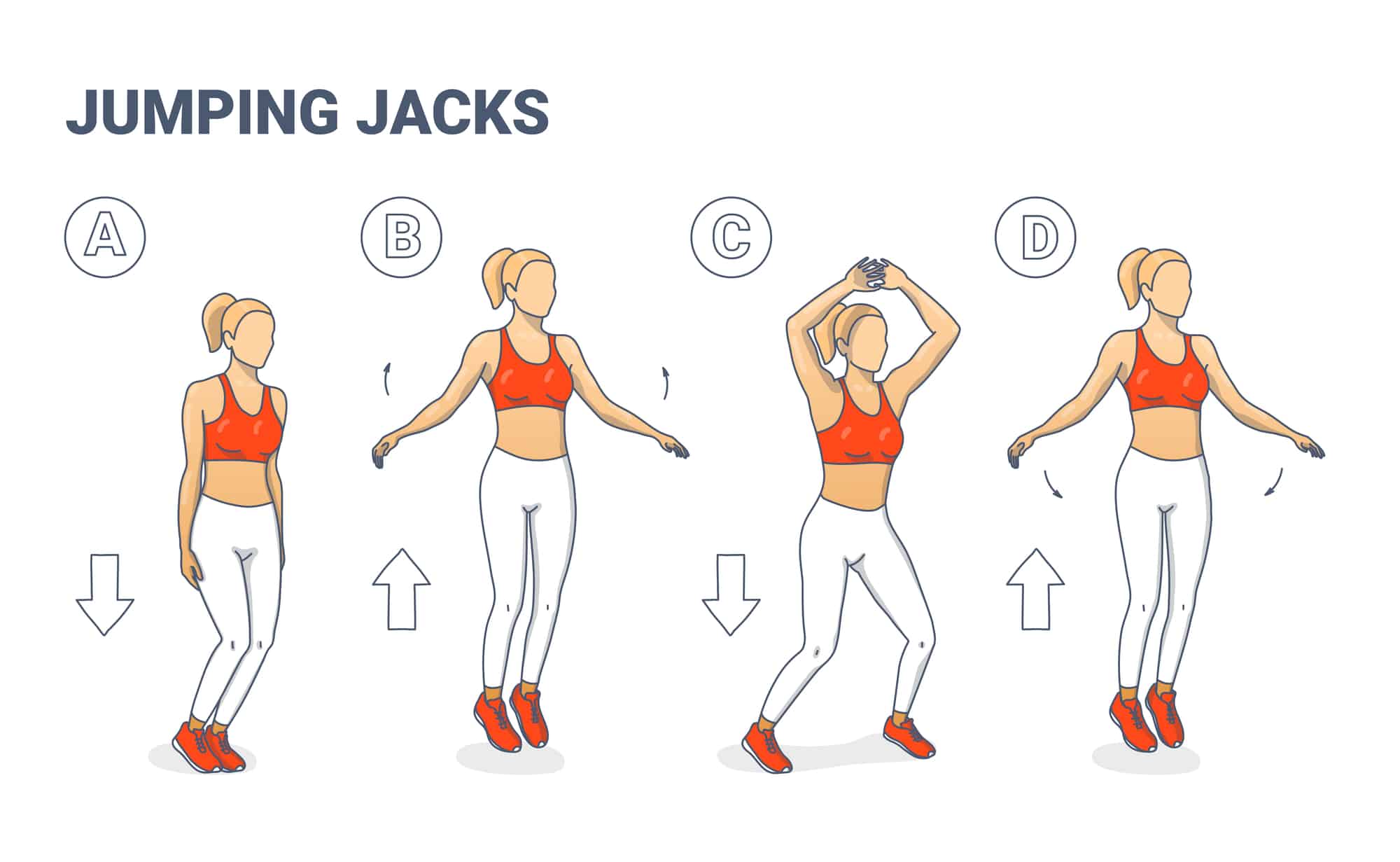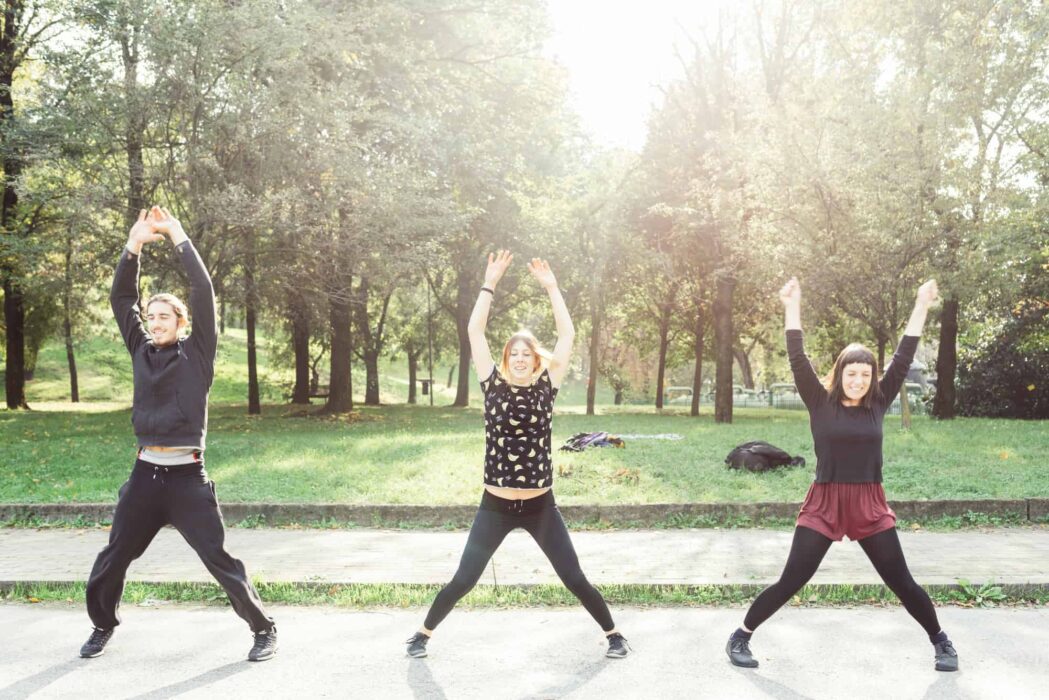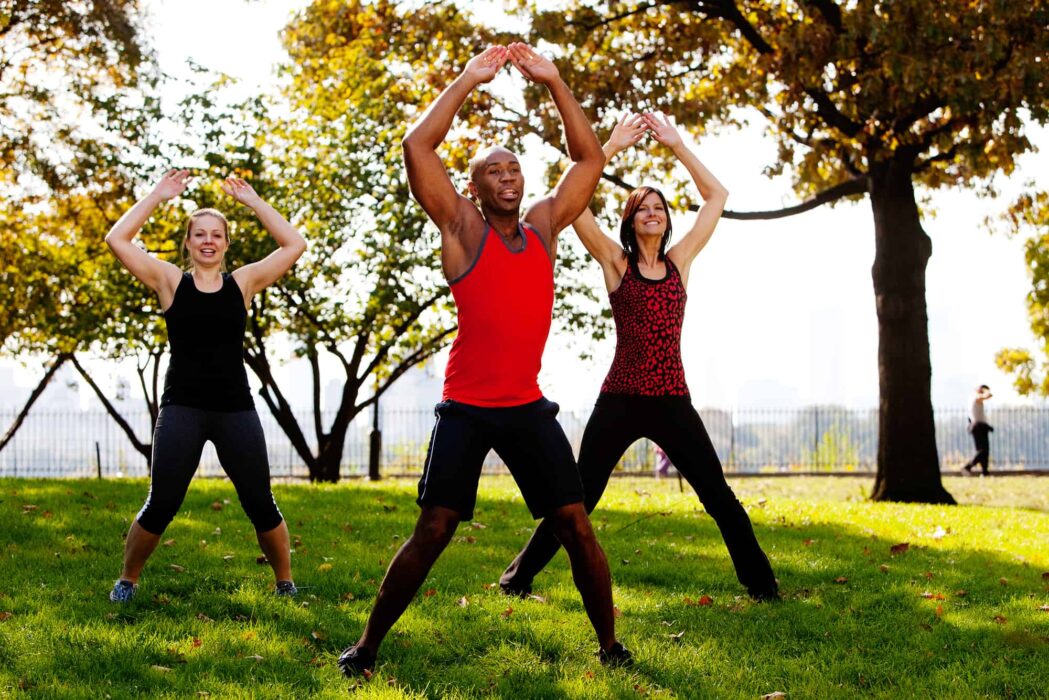Jumping Jacks seem like a fun exercise to do. It is a standard part of most pre-workout warm-ups and is one of the leading plyometric jumping exercises. But why do most fitness coaches and bloggers love it so dearly? What are the benefits?
Jumping jacks is a versatile full-body exercise that offers the perfect balance of easy technical execution, adjustable difficulty variations, effectiveness, and fun! Jumping jacks becomes a welcome addition to any fitness routine, either as a warm-up or cardio training. Among its benefits are both physical and mental improvements to your wellbeing.
The following are seven leading jumping jacks benefits that even beginners can experience to the full extent. People who don’t exercise at all can learn easily and quickly to jumpstart their fitness journey (pun intended!)
What’s The Proper Way to Do Jumping Jacks?

Overall, jumping jacks is a simple exercise that is easy to perform. But I mean the technical part; it becomes quite strenuous after half a minute or so! But how to do jumping jacks?
The right way to do jumping jacks is the following:
- Stand straight, feet together, arms relaxed. Keep your neck neutral.
- In one motion, jump your feet apart wider than shoulders, and move your hand all the way through the sides up. It should be one coordinated motion.
- Jump back to the initial position in a similar way.
This is how you do the basic jumping jacks. Easy, right? You can also clap your hands when they meet above your head. It’ll make the exercise fun!
Rowing Vs Running: Which is The Best Workout?
There are a few rules you have to follow as well:
- Warm-up. Although it can be a warm-up exercise on its own, if you are a beginner, you better do some minor stretching or even bodyweight squats before jumping jacks. Just get your body moving first.
- Be easy on your knees. If you feel discomfort in the knees, bend them a bit and jump lighter and smoother.
- Firm feet and ankles. A common mistake is not stabilizing your ankles when jumping. It can lead to injuries. Start the exercise in front of a mirror and make sure that your ankles are not swinging, bouncing, shaking, and so on.
Warnings:
- If you already have joint-related problems, I suggest consulting with your doctor first to determine the safety of jumping jacks for you.
- Pregnancy. Overall, OBGYNs do not prohibit jumping jacks specifically, but they recommend switching to low-impact aerobics. If you have an uncomplicated pregnancy, doing “half jacks” would be a safer option. Check the ProNatalFitness website [1] for alternative cardio exercises. Overall, a consultation with your doctor would be optimal.
- Kidney issues. If you are facing any type of kidney issues, it’s better to consult your doctor!
- The same concerns issues with blood pressure!
What Are Jumping Jacks Benefits?
Weight Loss
First and foremost, jumping jacks are used in cardio and HIIT sessions meant for weight loss. Incorporating fast interval training of big muscle groups has proven to increase the number of calories burnt in a minute.
How many calories do jumping jacks burn? On average, jumping jacks burn 100-180 calories in 15 minutes [2], depending on the intensity and your fitness and physical estimation.
According to Bodybuilding.com [3] and several personal trainers I know, the bigger muscle groups you use, the more calories you burn. And can it be more effective than straining your whole body? Jumping jacks certainly do that!
A side benefit of piling up jumping jacks into short HIIT sessions lies in boosting metabolism. Such a high-intensity workout boosts your metabolism even after you finish working out. The process begins during the session and lasts for hours afterward.
Heart Health

The second benefit is in direct correlation with jumping jacks being a cardio exercise. And what do cardio sessions strengthen if done in moderation? Heart health. But you already know all the benefits of various CARDIO exercises for our CARDIOvascular system that encompasses heart, blood, and blood vessels. I’ve already mentioned the best cardio workout for home and gym that you can check in my article!
High-intensity interval training, when done in moderation, strengthens your heart. Short bursts of elevated heartbeat alternated with short periods of rest train the system and make it more resilient in the future. However, you should remember a simple rule of safety:
HIIT intervals should get you up to at least 85 percent of your heart rate reserve [during work periods]. Then you should allow your heart rate to come all the way back down to 55-60 percent.
The basics of heart rate training as mentioned by Men’s Health [4].
8 Benefits of Regular Jumping Rope Training
Considering that jumping jacks only seem easy but are strenuous in practice, you should keep your heart rate in mind.
Stress Reliever
Let’s switch to the most pleasant benefit of jumping jacks. While the health benefits are seen in the long term, the fun stress relieving part is instant and positive during the very exercise.
Jumping jacks are fun primarily because they transfer us to our childhoods. We were “jumping like stars’’ in my childhood for sure. The pose brings up positive memories for many people.
Plus, doing intense physical exercise is just a way to free your mind from daily problems bugging you and clear your thoughts. As you jump, you only think about the exercise. You let go of your stress.
There is also a scientifically proven benefit of fitness to our mood. Have you ever noticed being elevated after a workout session? That’s all the work of endorphins that are released into your body after a strenuous exercise. They are neurotransmitters that help release pain and stress; people usually know them as happiness hormones. And the effect is “runner’s high.”
Thus, a series of jumping jacks elevates your mood both from psychological and physiological perspectives.
Builds Strength

However, jumping jacks are not only about fun and play; they are building your muscles while you relieve stress.
Jumping jacks are a calisthenics exercise meaning that they work with your body weight. However, calisthenics has proven to be effective enough to build muscle strength. What muscles do jumping jacks work again?
As you engage all body parts to do jumping jacks properly, you train them all in synchrony. So just imagine that a fun exercise that is *relatively* easy to do can still have you leaner, more toned, and stronger overall. What could be better?
Improves Stamina and Coordination

Alongside your strength, you get to improve your stamina and coordination with this exercise. Combined, these three aspects can actually improve the quality of your daily activities and movements.
Stamina is one of the critical factors when it comes to cardio exercises. Beginners always lack it, thus reducing the overall time of working out drastically. As you continue training, stamina comes on its own, primarily due to cardio exercises like jumping jacks. As you strengthen your heart, it boosts your stamina. Plus, stronger muscles can make exercise easier.
When it comes to coordination, the more complex the exercise, the better. Compound movements that involve moving around your whole body are more challenging for our brain to process initially.
Jumping jacks require a coordinated movement of legs and hands in different directions. It may not be the hardest, but it will improve your coordination as you go on.
Prevents Diabetes
This one is an unexpected benefit, but it’s among the most significant ones. Prevention and health support during Type 2 Diabetes. Regular training, especially cardio varieties, helps in managing your blood sugar and weight.
Studies have shown that regular exercise can prevent diabetes, even among people with the signs of prediabetes.
The American Diabetes Association (ADA) encourages people to get at least 150 minutes of moderate to vigorous-intensity aerobic activity per week.
Jumping jacks can be altered to be either moderate or vigorous upon your wish. They are easy from the technical point of view and come with low chances of injury.
Plus, studies show that aerobic activities increase insulin sensitivity, thus helping your body use it better. Overall, the different benefits of exercising during diabetes can be found in this article [6].
Improves Bone Health and Density

This is yet another significant hidden benefit of jumping jacks – improving bone health. Jumping exercises generally improve bone mineral density if done regularly.
The process is overall similar to the way we grow and strengthen muscles. A study conducted in 2009 [7] showed significant gains in bone density among test rats. Plus, they managed to maintain these over the next 24 weeks with minimal training!
Jumping jacks keep osteoporosis and osteoarthritis under control. Of course, it’s better to start exercising sooner rather than later to prevent such conditions. How many jumping jacks should I do then? By introducing as little as 200 jumps per week, you greatly improve your chances for pain-free movement in your senior years.
In Conclusion
Overall, jumping jacks are a fun exercise from our childhoods that turn out to be effective as well. It comes with benefits that strengthen your heart, bones, muscles, improve your mood, burn a decent number of calories, and is a super exercise from all sides.
Today, one of the biggest perks of jumping jacks is their budget and space friendliness. You can easily do them at home, in a small, with no equipment. At times when gyms might be closed, this is an essential factor.
I hope you include jumping jacks in your fitness routine as well, so you can enjoy all the benefits while doing something fun!
Sources:
- Cardio Modifications for Pregnancy (2017, pronatalfitness.com)
- How many calories do you burn doing Jumping Jacks? (burned-calories.com)
- Burn the Most Fat, Build the Most Muscle (2021, www.bodybuilding.com)
- You Need To Start Adding Heart Rate Training To Your Workouts (2018, www.menshealth.com)
- 10 Exercises for Diabetes: Walking, Yoga, Swimming, and More (www.healthline.com)
- Diabetes and Exercise (www.diabetes.org.uk)
- Ooi, F.K., Singh, R., Singh, H.J. et al. Minimum level of jumping exercise required to maintain exercise-induced bone gains in female rats. Osteoporos Int 20, 963–972 (2009). (https://doi.org/10.1007/s00198-008-0760-6 )
 Fact checked by
Fact checked by 